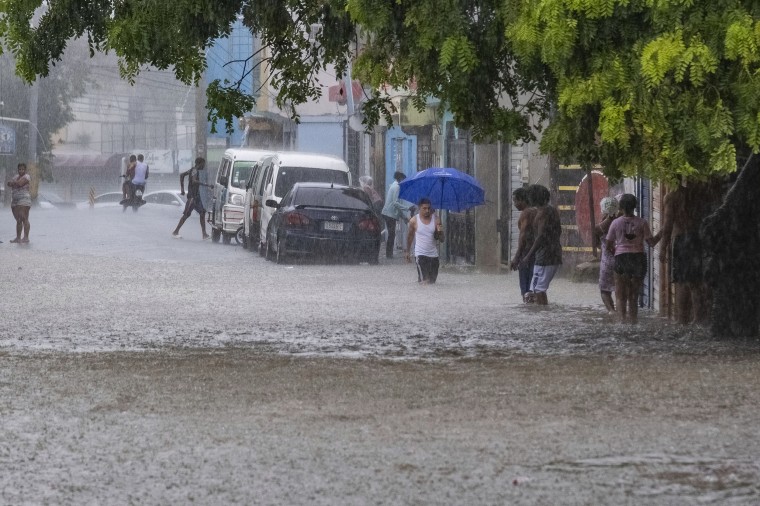SANTO DOMINGO, Dominican Republic — Tropical Storm Franklin made landfall Wednesday on the island of Hispaniola shared by the Dominican Republic and Haiti, bringing fears it would trigger deadly landslides and heavy flooding in both countries.
Franklin was expected to swirl above the island for most of the day, with forecasters warning the storm could dump up to 10 inches (25 centimeters) of rain, with a maximum of 15 inches (38 centimeters) for the central region of Hispaniola.
On Wednesday morning, the storm was centered about 105 miles (170 kilometers) west-southwest of Santo Domingo, the capital of the Dominican Republic, according to the National Hurricane Center in Miami. It had maximum winds of 50 mph (85 kph) with higher gusts and was moving northward at 10 mph (17 kph). It made landfall along the country’s southern coast near Bahahona.
Emergency operations officials said they were looking for a 54-year-old man with mental health problems who went missing after he jumped into a creek late Tuesday.
Meanwhile, Tropical Storm Harold weakened into a tropical depression Tuesday night after making landfall in South Texas, bringing strong winds, rain and leaving thousands of homes without power.
In the Caribbean, officials were most concerned about Franklin’s impact in Haiti, which is vulnerable to catastrophic flooding given the country’s severe erosion.
Prime Minister Ariel Henry had urged Haitians on Tuesday to stock up on water, food and medication as authorities checked on some of the more than 200,000 people displaced by gang violence, with some living on the street or in makeshift shelters.
Some recalled how a powerful thunderstorm that unleashed heavy rains one day in June left more than 40 people dead across Haiti.
In the Dominican Republic, officials shuttered schools, government agencies and several airports with at least 24 of the country’s 31 provinces under red alert. By early Wednesday, more than 40 aqueducts were out of service because of heavy rains, affecting more than 830,000 customers.
Flooding already had been reported on Tuesday in Santo Domingo and beyond, where residents prepared for heavy rainfall as authorities evacuated 31 families.
“We’re scared of the river,” said Doralisa Sánchez, a government employee who lives near the Ozama River that divides the capital and has had to flee her home three times during previous storms.
She hoped Franklin wouldn’t force her to seek shelter and temporarily abandon her home because she said people steal belongings left behind.
Others, like businesswoman Albita Achangel, worried they had nowhere to go if the waters start rising.
“We are hoping for God’s will,” she said, adding that her patio already was flooded.
The storm worried thousands of Dominicans who live in flood-prone areas.
“When two drops of water fall here, this suddenly becomes flooded,” said Juan Olivo Urbáez, who owns a small business in a community near the Ozama River.
A tropical storm warning was in effect for the entire southern coast of the Dominican Republic and Haiti, as well as the entire northern Dominican coast. The government of the Bahamas also issued a tropical storm warning for the Turks and Caicos Islands, according to the National Hurricane Center in Miami.
Franklin is the seventh named storm of the Atlantic hurricane season, which runs from June 1 to Nov. 30. An eighth named storm, Gert, dissipated on Tuesday.
On Aug. 10, the National Ocean and Atmospheric Administration updated its forecast and warned that this year’s hurricane season would be above normal. Between 14 to 21 named storms are forecast. Of those, six to 11 could become hurricanes, with two to five of them possibly becoming major hurricanes.
